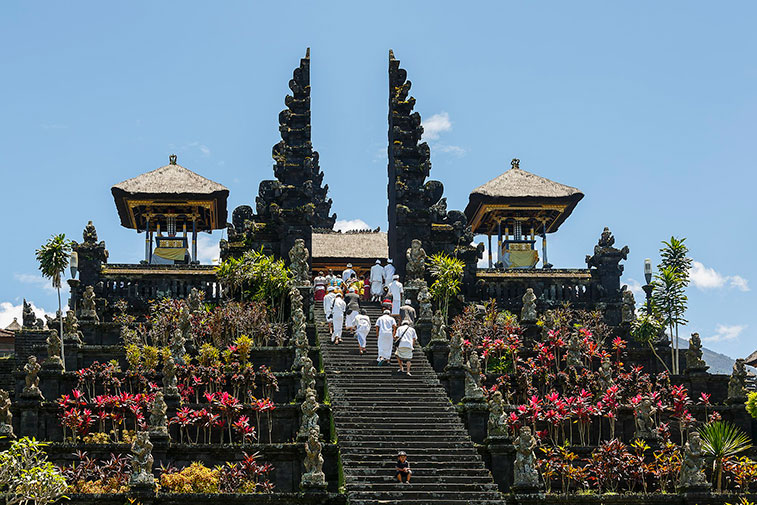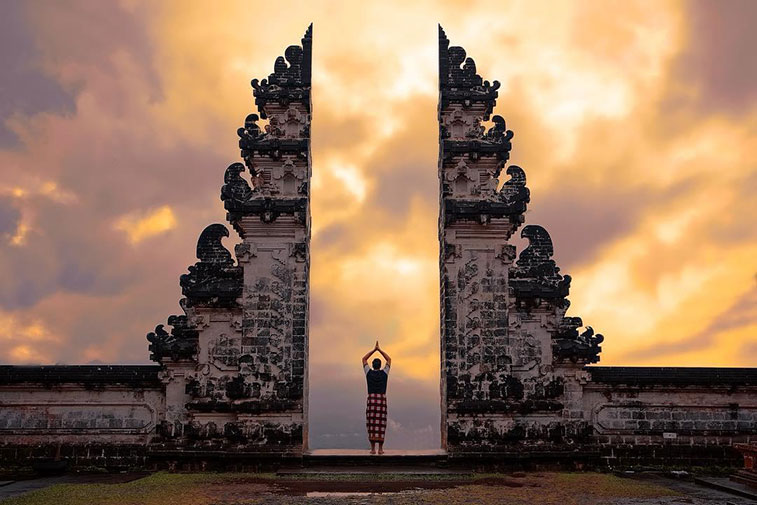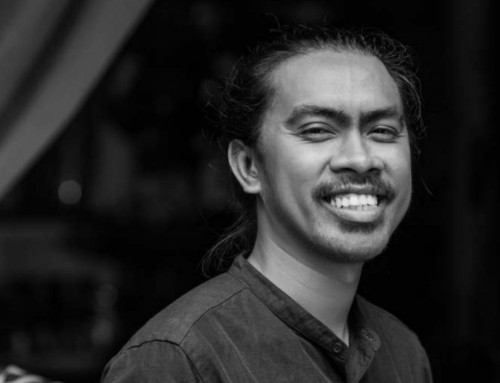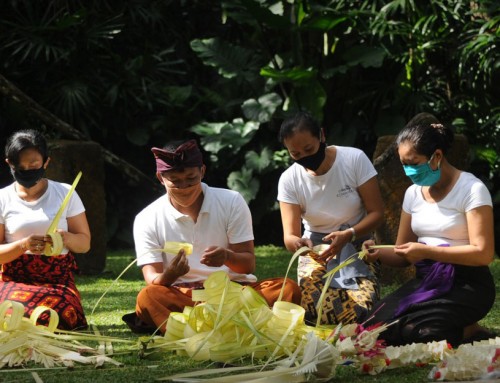Bali is known as ‘the island of a thousand temples’. In fact there are many thousands of temples (pura) from small shrines to major temples, throughout the island. A temple is where the Balinese honor their deities with offerings, music, and ritual dance. Temples are supported by their surrounding communities, who come to pray on the temple’s anniversary festival (odalan). Every village has at least three community temples. Some major temples draw worshippers from all over the island. Bali’s temple architecture is unique to the island and follows a sacred building code — but every temple is different, often with wonderful carving in stone and wood. To truly experience Bali, be sure to visit one or two temples and get close to the heart of the island’s spiritual reality.
When visiting a temple, certain cultural customs apply to both Balinese and visitors. You must dress appropriately — at the least, wear a temple sash (often available for loan outside the temple). Also, you must be in a good, gentle temper, not be in mourning, and not menstruating (this is a taboo against blood in a temple).
Here are 10 temples that welcome visitors:
1
Besakih
Pura Besakih spreads over the slopes of Mount Agung, with beautiful views to the ocean. Many Balinese consider Pura Besakih the most important temple in Bali. It is comprised of many temples, with Pura Penataran Agung at the center. On Purnama Kedasa (the full moon around March or April) a big festival called Ida Betara Turun Kabeh is held at Pura Penataran Agung, in which the deities of the four cardinal points are invited to descend and be honored. Once every five years, the enormous Panca Wali Krama rituals are held at Pura Besakih — and it is being held in 2019 until mid-April. Balinese Hindus from all over the island will come and pray.

Photo courtesy of CEphoto, Uwe Aranas
2
Lempuyang
Pura Penataran Agung Lempuyang, also known as Pura Lempuyang Luhur, is one of the oldest and most sacred temples in Bali. Located on the top of Mount Lempuyang, this temple is actually a collection of temples along the path to the top. The summit is at 1,175 meters above sea level, and reached by a long series of over 1,700 steps.

Photo courtesy of baliventur.com
3
Batur
Pura Ulun Danu Batur, or Pura Batur, is located in the highland area of Kintamani, Bangli district. The sacred Mount Batur and Batur Lake are clearly visible from this temple. A big ceremony is held once a year, at the same time as the one at Besakih. This temple is important to all the irrigated rice farming communities of central and eastern Bali.

Photo courtesy of kintamani.id
4
Kehen
Pura Kehen is also located in Bangli district, in the village of Cempaga near the town of Bangli. The temple is a magnificent example of Balinese architectural artistry, and was once the main temple of the Bangli kingdom. During temple festivals, people come from neighboring villages to pray.

Photo courtesy of en.wikipedia.org
5
Tanah Lot
Pura Tanah Lot, on the southwest coast in Tabanan district, is a dramatically situated temple on a large rock in the surf of the sea. Under the temple is a small cave where sea snakes live, believed to be temple guardians. Many visitors come to this temple in the late afternoon to watch the sunset. An amazing sight!

Photo courtesy of planbalitrip.com
6
Uluwatu
Famous for its natural beauty and sacred atmosphere, on a cliff 97 meters above the sea, Pura Luhur Uluwatu is one of Bali’s major temples. Around the temple is a forest inhabited by monkeys, who often come to the temple to eat leftover offerings. The monkeys can be naughty, so you should watch your hat and glasses and not wear eye-catching jewelry. The local community performs a Kecak dance every evening; tickets required.

Photo courtesy of @omerrana
7
Taman Saraswati
Pura Taman Saraswati is dedicated to Dewi Saraswati, the deity of knowledge and the arts. This temple was built by I Gusti Nyoman Lempad (ca. 1862–1978), a master artist from Ubud. The temple is beautifully designed with gardens and a large pond filled with lotus. It is behind the famous Café Lotus in central Ubud, and there are often cultural performances staged in front of the temple — so there are many reasons to visit!

Photo courtesy of somethingoffreedom.com
8
Tirta Empul
One of the most visited temples is Pura Tirta Empul in the highlands of Tampak Siring in Gianyar district. There are beautiful spring-fed pools where people come to purify themselves under a long line of spouts of cold spring water. Visitors are welcome to participate.

Photo courtesy of @fgiorgio
9
Goa Lawah
Pura Goa Lawah, also known as the Bat Cave Temple, is located on the seacoast in Klungkung Regency. The temple is at the mouth of a large cave which is inhabited by thousands of bats and, it is said, serpents. Because it faces the sea, it is a place from which to honor Batara Segara, the god of the sea, a stage in the purification of ancestors after cremation.

Photo courtesy of travellers.minube.net/robertogonzalez893
10
Goa Gajah
Pura Goa Gajah, also known as the Elephant Cave, is an archeological complex with a long history, with traces of both Hindu and Buddhist imagery. It is thought to have been a place of meditation in the 11th century. Steps lead down to an open area with an ancient bathing pool and a cave whose stone entrance is carved with a gigantic demonic face and many phantasmagorical images. Inside the shallow cave are sacred statues. This temple is only a short drive to the east of Ubud, in Gianyar district.














Leave A Comment